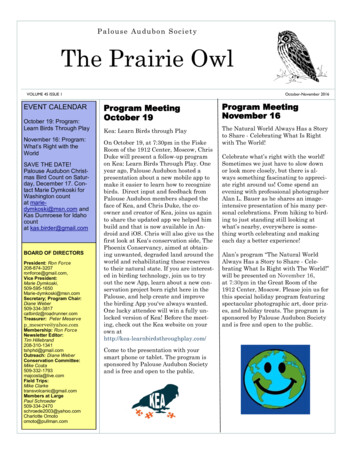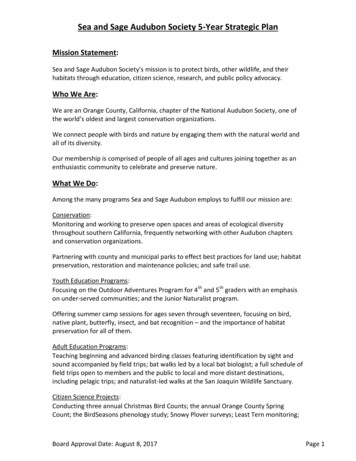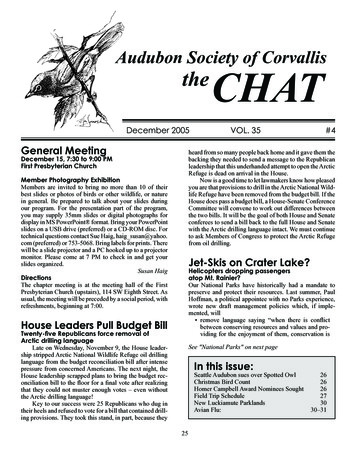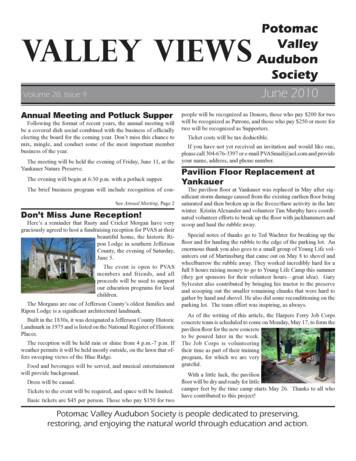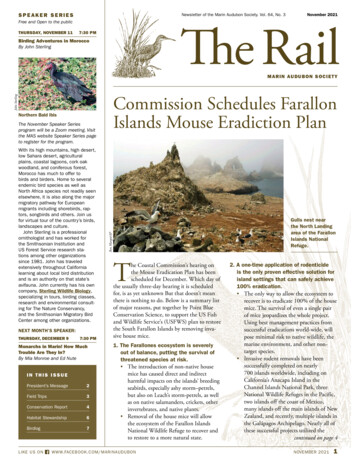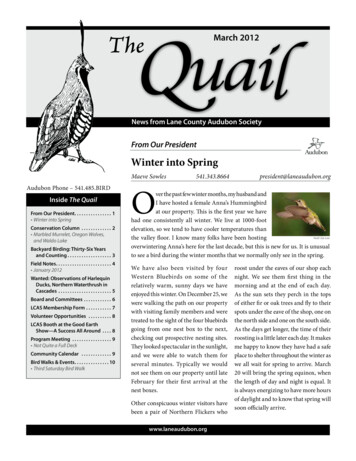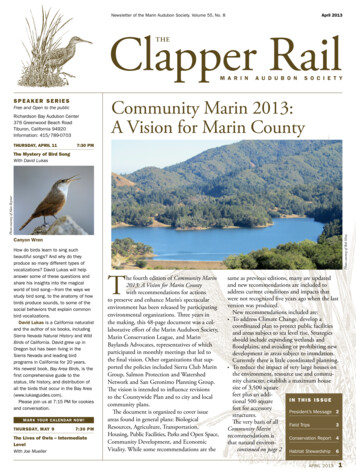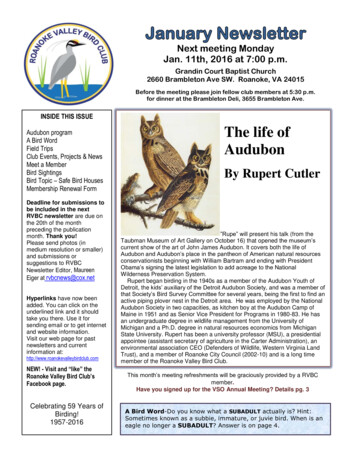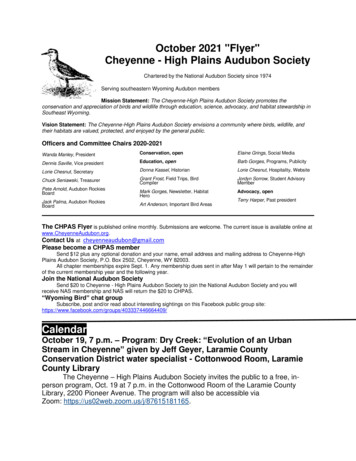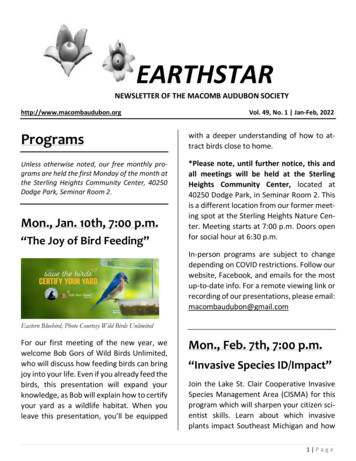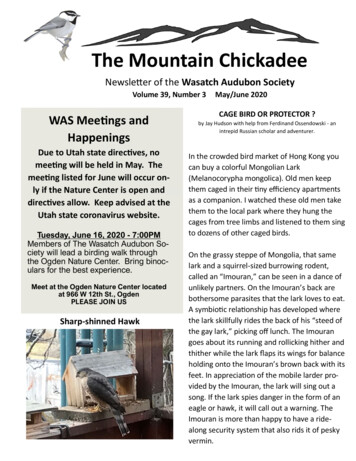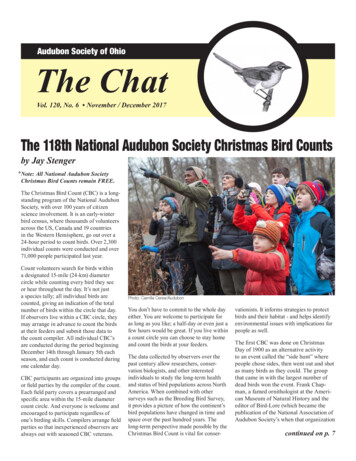
Transcription
Audubon Society of OhioThe ChatVol. 120, No. 6 November / December 2017The 118th National Audubon Society Christmas Bird Countsby Jay Stenger* Note: All National Audubon SocietyChristmas Bird Counts remain FREE.The Christmas Bird Count (CBC) is a longstanding program of the National AudubonSociety, with over 100 years of citizenscience involvement. It is an early-winterbird census, where thousands of volunteersacross the US, Canada and 19 countriesin the Western Hemisphere, go out over a24-hour period to count birds. Over 2,300individual counts were conducted and over71,000 people participated last year.Count volunteers search for birds withina designated 15-mile (24-km) diametercircle while counting every bird they seeor hear throughout the day. It’s not justa species tally; all individual birds arecounted, giving an indication of the totalnumber of birds within the circle that day.If observers live within a CBC circle, theymay arrange in advance to count the birdsat their feeders and submit those data tothe count compiler. All individual CBC’sare conducted during the period beginningDecember 14th through January 5th eachseason, and each count is conducted duringone calendar day.CBC participants are organized into groupsor field parties by the compiler of the count.Each field party covers a prearranged andspecific area within the 15-mile diametercount circle. And everyone is welcome andencouraged to participate regardless ofone’s birding skills. Compilers arrange fieldparties so that inexperienced observers arealways out with seasoned CBC veterans.Photo: Camilla Cerea/AudubonYou don’t have to commit to the whole dayeither. You are welcome to participate foras long as you like; a half-day or even just afew hours would be great. If you live withina count circle you can choose to stay homeand count the birds at your feeders.The data collected by observers over thepast century allow researchers, conservation biologists, and other interestedindividuals to study the long-term healthand status of bird populations across NorthAmerica. When combined with othersurveys such as the Breeding Bird Survey,it provides a picture of how the continent’sbird populations have changed in time andspace over the past hundred years. Thelong-term perspective made possible by theChristmas Bird Count is vital for conser-vationists. It informs strategies to protectbirds and their habitat - and helps identifyenvironmental issues with implications forpeople as well.The first CBC was done on ChristmasDay of 1900 as an alternative activityto an event called the “side hunt” wherepeople chose sides, then went out and shotas many birds as they could. The groupthat came in with the largest number ofdead birds won the event. Frank Chapman, a famed ornithologist at the American Museum of Natural History and theeditor of Bird-Lore (which became thepublication of the National Association ofAudubon Society’s when that organizationcontinued on p. 7
ProgramsNov. 20th: A Romp through Ohio’s Flora and FaunaThis program will bea pictorial adventure; awander through Ohio’svaried habitats with visitsto flora and fauna greatand small. We’ll look atwell-known plants andanimals, and obscurespecies that few haveheard of or encountered.Overarching all is theimportance of ALL thecogs of the ecologicalwheel, and the need toprotect everything.Jim worked for the OhioDepartment of NaturalResources for 31 yearsas a botanist, and laterspecializing in wildlifediversity projects,especially involvingbirds. He has authoredor coauthored six books,including Birds of Ohio(Lone Pine 2004); andWild Ohio: The Best ofOur Natural Heritage(Kent State UniversityPress 2009). The latterwon the 2010 OhioanaBook award. He is acoauthor of the OhioBreeding Bird Atlas IIbook. Jim writes a column,Nature, for the ColumbusDispatch, and regularlypublishes a natural historyblog. He has writtennumerous articles in avariety of publications,and has deliveredhundreds of presentationsthroughout the easternUnited States. He wasnamed 2015 ConservationCommunicator of theYear by the Ohio Leagueof Sportsmen. Jim isan avid photographer,shooting a range of naturalhistory subjects. He hashad hundreds of photospublished in variousforums.Audubon programs are held on the third Mondayof the month (not including January, July, August orDecember). We meet at 7 p.m. for light refreshments,with the program beginning at 7:30 p.m. We meet atthe Winton Woods Visitor Center, located at 10245Winton Road.Note that a Park District auto sticker is required – 3.00daily or 10.00 annual for Hamilton County residents, or 5.00 daily or 14.00 annual for non-residents.No Audubon Meeting in DecemberThere will be no Audubon Society meeting in the month of December, to allowfull participation in the Christmas Bird Counts. Our regular Monthly Meetings willresume in January.Page 2The Chat
Field Trips (contributed by Jay Stenger)Saturday, Nov. 18th,8 a.m.Theme: Waterfowl & LateFall MigrantsLocation: Brookville Lake AreaCo-Leader: Jack Stenger, (513)503-3389, jackstenger@gmail.comCo-Leader: Jay Stenger, (513) 5228147, jaystenger@cinci.rr.comMeet: at the Park & Ride Lot atI–275 Exit # 7.(see directions below)* NOTE: This field trip will beconducted jointly with the AudubonSociety and the Cincinnati BirdClub.The focus of this trip will be the fallwaterfowl migration, which should benear peak at this date. Our trip leadersplan to visit several spots aroundBrookville Lake and then make theshort hop over to Hueston Woodsbefore returning home. Both of theselocations are hotspots and are excellentfor attracting waterfowl and water birdsat this season. The rural countrysidesurrounding these two large lakes hasdiverse habitats so we expect to find agreat variety and diversity of speciesthroughout the day. In addition to manyspecies of waterfowl we also expectto see loons, grebes, gulls, SandhillCranes, late shorebirds (such as Dunlin& Wilson’s Snipe), Bald Eagles, manyhawks, numbers of seasonal songbirdsand much more. Rare species arealways possible. Prairie Falcon andGolden Eagle have been seen on thistrip in recent years.This will be an auto type tour andwill consist of driving from spot tospot interspersed with a few shortPage 3Sandhill Crane Allan Clayboneasy walks. While the trip duration islong and does entail a lot of driving,the rewards, in terms of what we see,always make it worth the effort.The trip will run into mid afternoonbut of course you can leave at any timeyou like. Bring your lunch and drinks.It always seems colder around largelakes so dress accordingly. If you havea scope it will prove useful. Restroomswill be available. One important note,Indiana State Parks charges a daily percar entrance fee ( 5 resident, 7 nonresident). At this time of year there areusually no attendants on duty but wecannot be sure of that.We will meet at 8 a.m. at the park &ride lot, located right at the I-275 Exit #7 at SR 128 marked Cleves-Hamilton.This is the first exit just west of theGreat Miami River at Miamitown.We will caravan from there to theBrookville area, about a 30-minutedrive. Call or email Jack if you haveany questions.Visit the Brookville Lake website at:http://www.in.gov/dnr/parklake/2961.htmVisit the Whitewater MemorialState Park (at Brookville Lake)website at:http://www.in.gov/dnr/parklake/2962.htmVisit the Hueston Woods SPwebsite at:http://parks.ohiodnr.gov/huestonwoodsaround the valley . . .Oxbow, Inc.Fall Waterfowl MigrationSun., November 5th, 8 a.m.Leader: Gary Stegner,(812) 667-6433,garyandsally@hotmail.comMeet: In the upper Oxbowparking lot at the main entranceto the OxbowCincinnati Nature CenterBird WalkSaturday, Nov. 25th & Dec. 9thMeet in the Rowe Woodsparking lot at 8 a.mThe Chat
ConservationClimate Actionby Chris MoranThe Federal government is retreatingfrom efforts to reduce greenhousegas emissions and move to cleanerenergy. Other entities continue effortsto reduce the use of fossil fuel: states,cities, companies such as Dell, P&G,HP among others, and non-profitorganizations including Audubon.http://sciencebasedtargets.org/Some states have formed a U.S. Climate Alliance committed to the goalof reducing greenhouse gas emissions consistent with the goals of theParis Agreement, the United Nationssponsored world-wide pledge to reduce greenhouse gas emissions. Ohiois not part of the Climate Alliance. Inthis coalition the larger states of California, Colorado and New York areleading the country’s emissions reductions. Implementing those states’The Chatclimate action plans has contributedto the state’s growing economy.U.S. Mayors are working on climateprotection efforts under a MayorsClimate Protection Agreement.Signatories pledge to reduce theircity’s greenhouse gas emissions andurge the federal government and theirstate government to enact emissionreduction legislation. Cincinnati isa participant and has had a ClimateProtection Plan currently being updated.www.greencincinnatiplan.comBe part of moving toward less polluting, more efficient and renewablesources of energy. Be informed aboutthe results of fossil fuel usage fromits extraction to its burning. Contactyour elected officials especially yourstate representative and senator andfederal House Representative andSenators. A simple message expressing support for renewal energysources is helpful. A message informsthese representatives that there areconstituents who are interested andwant clean energy.Reduce your contributions to fossilfuel use by using energy efficientappliances and fixtures at homeand turn them off when not in use.Make energy efficient transportationchoices including walking.For Ohio senators and representatives: www.ohiosenate.govwww.house.state.oh.usFor Senator Sherrod Brown:www.brown.senate.govFor Senator Rob Portman:www.portman.senate.govFor your US House:http://www.house.gov/Page 4
MigrationHold Onto Your Bins: Another Blizzard of Snowy Owls Could Be ComingSnowy Owl. Photo by Lana Haysby Leslie NemoNational Audubon SocietyFour years ago, thousands ofSnowy Owls stormed the northern United States, taking upposts in surroundings drasticallydifferent from the flat Arctictundra over which they typically preside. Some whiled awaythe hours peering at dog walkers from suburban fences; onelearned to hunt around a Minnesota brewery with mouse problems. In a typical winter, around10 Snowies visit Pennsylvania,but in 2013 the state was gracedby 400. They were part of thelargest Snowy Owl irruption, orinflux of a species into a placethey don’t usually live, the U.S.Page 5has seen since the 1920s.If you missed it, you might bein luck. Project SNOWstorm, avolunteer-fueled Snowy Owltracking organization foundedafter that irruption, predicts another wave of Arctic raptors willhit North America this winter,according to their most recentblog post.Scott Weidensaul, one of the directors of Project SNOWstorm,says the clues point to a big irruption, but the group also fullyadmits there’s no way to definitively know how big it could beor if it will even happen at all.“There’s a little bit of voodooand black magic in all of this,”Weidensaul says. Though SnowyOwl migration patterns are mostly mysterious, there have beensome tell-tale signs that the birdsare on their way.For one, some Snowy Owlsalready seem to be retracing thelast irruption’s process. Dataare sketchy and variable, butit appears that big southwardmovements occur about onceevery four years. That’s becauselemmings, their preferred prey,go through regional populationexplosions at about the same interval. In 2013, those little Arcticrodents had a banner year on theUngava Peninsula in NorthernQuebec, fueling a highly successful breeding season for thecontinued on p. 6The Chat
Migration (continued from p. 5)Interactive map showing location of confirmed Snowy Owl sightings, available on Project SNOWstorm’s website. Red pins are females, blue pins are males.owls that flocked to that area.Sure enough, this past breedingseason, Canadian wildlife biologists studying caribou reportedan unusually high number ofowls flapping around the samearea, reports others have confirmed.Early stateside migrators havealso been spotted. A couplehundred have flocked to theNortheast and Upper Midwest,Weidensaul says—single birdshave been spotted as far south asOklahoma, Missouri, and NorthCarolina—and their numbers arebuilding faster than they did in2013. When more of the speciescatch up, SNOWstorm volunteers will know for sure if theirruption is bona fide, and whereit will hit hardest.Part of the uncertainty in predicting this year’s potentialirruption stems from the lack ofpeople monitoring Snowy OwlThe Chatnests in the wilderness of northern Quebec. According to Weidensaul, nests held eight or nineeggs each in 2013—far morethan the typical three to four.Those unusually large clutchescontributed to the impressivenumbers from a few years ago.Without an estimate of recentclutch sizes, SNOWstorm can’tpredict how big this inundationcould be.No matter how many ultimatelyshow up, these birds are tough.People often assume that if theysee an Arctic bird in, say, Indiana, it must be sick or starving.In reality, these Snowy Owlsare fairly fat and healthy, saysWeidensaul, and will eat anything they find. That includesthe Snowy found gnawing ona bottle-nosed dolphin carcassin Delaware a few years ago,fending off its find from TurkeyVultures.Sometimes, though, the birdsstruggle to navigate developedlandscapes full of buildingsand telephone wires. Airportrunways especially lure SnowyOwls in with their flat, treelessexpanses, where planes takingoff pose a danger, says Weidensaul. If seriously injured, thebirds might need assistance, butotherwise, people shouldn’t gettoo close. Young owls who haveno experience with humans oftenlet birders and photographers approach them; these interactionscan end with the birds backingup into highways and other dangerous situations.Weidensaul doesn’t blame people for being curious—the birdsare a rare glimpse of Arctic lifethat deserve all of the attention.As he says, “you’re not going tosee a polar bear walking throughyour neighborhood.”Page 6
Conservation (continued from p. 1)Christmas Bird Countsformed in 1905) recognized that declining bird populations could not withstandwanton over-hunting, and proposed tocount birds on Christmas Day rather thanshoot them.There are many Christmas Bird Countsto choose from and we encourage you totake part in as many as possible. But wealso hope you can find the time to participate in at least one of our local ChristmasBird Counts listed below. If you have anyquestions concerning a particular countfeel free to contact that count’s compiler.For more information on AudubonSociety Christmas Bird Counts visit thefollowing unt.The ChatRemember the DatesNational Audubon Society Local Christmas Bird Counts (CBC)Ohio River (Oxbow) CBCDate: Saturday, December 16, 2017Compiler: Jack Stenger, (513) 503-3389,jackstenger@gmail.comWestern Hamilton County CBCDate: Saturday, December 23, 2017Compiler: Ned Keller, (513) 349-3369,nedkeller49@gmail.comHamilton–Fairfield CBCCincinnati CBCDate: Saturday, December 16, 2017Compiler: Mike Busam, (513) 259-3262,mbusam@gmail.comEast Fork CBCDate: Saturday, December 30, 2017Co-Compiler: Jack Stenger, (513) 5033389, jackstenger@gmail.comCo-Compiler: Jay Stenger, (513) 5228147, jaystenger@cinci.rr.comDate: Sunday, December 17, 2017Compiler: Joe Bens, (513) 353-4229,joebens@live.comPage 7
Audubon Societyof Ohio3398 W. Galbraith Rd.Cincinnati, OH 45239513-741-7926 (SWAN)mail@cincinnatiaudubon.orgPresidentNed KellerVice PresidentJohn StewartTreasurerJay StengerSecretaryChris MoranCommunicationsNed KellerField TripsJay StengerPreservesJim MundyNewsletterMark GilsdorfProgramsHarris AbramsonSocial MediaRichard AmableOutreachPenny BorgmanFacilitiesBrian KeaneMember-at-LargeHeather FarringtonOur mission is to promote the conservationand appreciation of nature for environmentalsustainability with a focus on birds, throughhabitat protection and educationBecome a Friend of the Audubon Society of OhioMembership form for the Cincinnati Chapter of the National Audubon Society.Enclose a check or money order payable to “ASO.”Membership: 1 Year ( 15) Family ( 25) Additional ContributionName:Address:City: State: Zip:Phone (home) (cell):E-mail:Mail to:ASO3398 W. Galbraith Rd.Cincinnati, OH 45239Your information will not be shared with any other group
Nov 12, 2017 · The 118th National Audubon Society Christmas Bird Counts . by Jay Stenger. Note: All National Audubon Society . Christmas Bird Counts remain FREE. The Christmas Bird Count (CBC) is a long-standing program of the National Audubon Society, with over 100 years of citizen science involvement. It is an early-wi
